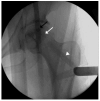Evaluation of Safety and Efficacy of Cell Therapy Based on Osteoblasts Derived from Umbilical Cord Mesenchymal Stem Cells for Osteonecrosis of the Femoral Head: Study Protocol for a Single-Center, Open-Label, Phase I Clinical Trial
- PMID: 39459006
- PMCID: PMC11510171
- DOI: 10.3390/ph17101366
Evaluation of Safety and Efficacy of Cell Therapy Based on Osteoblasts Derived from Umbilical Cord Mesenchymal Stem Cells for Osteonecrosis of the Femoral Head: Study Protocol for a Single-Center, Open-Label, Phase I Clinical Trial
Abstract
Although mesenchymal stem cells (MSCs) insertion has gained recent attention as a joint-preserving procedure, no study has conducted direct intralesional implantation of human umbilical cord-derived MSCs (hUCMSCs) in patients with ONFH. This is a protocol for a phase 1 clinical trial designed to assess the safety and exploratory efficacy of human umbilical cord-derived osteoblasts (hUC-Os), osteogenic differentiation-induced cells from hUCMSCs, in patients with early-stage ONFH. Nine patients with Association Research Circulation Osseous (ARCO) stage 1 or 2 will be assigned to a low-dose (1 × 107 hUC-O cells, n = 3), medium-dose (2 × 107 cells, n = 3), and high-dose group (4 × 107 cells, n = 3) in the order of their arrival at the facility, and, depending on the occurrence of dose-limiting toxicity, up to 18 patients can be enrolled by applying the 3 + 3 escalation method. We will perform hUC-O (CF-M801) transplantation combined with core decompression and follow-up for 12 weeks according to the study protocol. Safety will be determined through adverse event assessment, laboratory tests including a panel reactive antibody test, vital sign assessment, physical examination, and electrocardiogram. Efficacy will be explored through the change in pain visual analog scale, Harris hip score, Western Ontario and McMaster Universities Osteoarthritis Index, ARCO stage, and also size and location of necrotic lesion according to Japanese Investigation Committee classification before and after the procedure. Joint preservation is important, particularly in younger, active patients with ONFH. Confirmation of the safety and efficacy of hUC-Os will lead to a further strategy to preserve joints for those suffering from ONFH and improve our current knowledge of cell therapy.
Keywords: CF-M801; cell therapy; core decompression; hip; osteoblast; osteonecrosis of the femoral head; umbilical cord-derived mesenchymal stem cell.
Conflict of interest statement
The authors declare no conflict of interest.
Figures





Similar articles
-
Stem cell therapy for osteonecrosis of femoral head: Opportunities and challenges.Regen Ther. 2020 Nov 28;15:295-304. doi: 10.1016/j.reth.2020.11.003. eCollection 2020 Dec. Regen Ther. 2020. PMID: 33426232 Free PMC article. Review.
-
Efficacy of umbilical cord-derived mesenchymal stem cell-based therapy for osteonecrosis of the femoral head: A three-year follow-up study.Mol Med Rep. 2016 Nov;14(5):4209-4215. doi: 10.3892/mmr.2016.5745. Epub 2016 Sep 16. Mol Med Rep. 2016. PMID: 27634376 Free PMC article. Clinical Trial.
-
Efficacy of robot-assisted core decompression combined with human umbilical cord-derived mesenchymal stem cell transplantation for osteonecrosis of the femoral head.Eur Rev Med Pharmacol Sci. 2022 Jun;26(12):4197-4206. doi: 10.26355/eurrev_202206_29056. Eur Rev Med Pharmacol Sci. 2022. PMID: 35776018
-
Allogeneic human umbilical cord-derived mesenchymal stem cells for severe bronchopulmonary dysplasia in children: study protocol for a randomized controlled trial (MSC-BPD trial).Trials. 2020 Jan 31;21(1):125. doi: 10.1186/s13063-019-3935-x. Trials. 2020. PMID: 32005282 Free PMC article.
-
Umbilical Cord-Derived Stem Cells for the Treatment of Knee Osteoarthritis: A Systematic Review.Orthop J Sports Med. 2022 Jul 14;10(7):23259671221104409. doi: 10.1177/23259671221104409. eCollection 2022 Jul. Orthop J Sports Med. 2022. PMID: 35859650 Free PMC article. Review.
Cited by
-
Core decompression, allogenic fibula fixation, and pedicled fibula grafting are effective for osteonecrosis of femoral head.Am J Transl Res. 2025 Mar 15;17(3):1768-1779. doi: 10.62347/SRDE9412. eCollection 2025. Am J Transl Res. 2025. PMID: 40225979 Free PMC article.
References
Grants and funding
LinkOut - more resources
Full Text Sources

